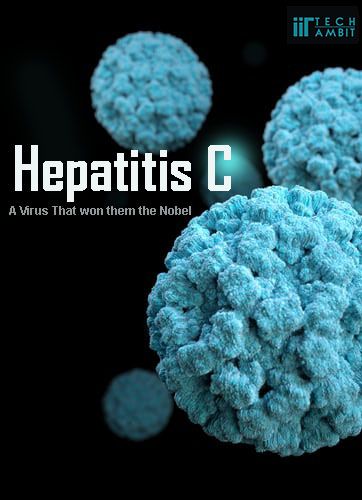Who received the Nobel?
Harvey J. Alter, Michael Houghton and Charles M. Rice together were awarded the Nobel prize for Physiology or medicine 2020 for the discovery of Hepatitis C virus.
Harvey J. Alter is the former chief of the infectious diseases section and the associate director of research for the department of Transfusion Medicine at the Warrant Grant Magnuson Clinical center in the National Institutes of Health in Bethesda, Maryland. In the mid 1970s he and his team proved that the post transfusion hepatitis cases were not due to Hepatitis A or Hepatitis B.
Michael Hougton is a British scientist who is best known for his discovery of the Hepatitis C genome. Charles M. Rice is an American virologist who is known for procuring the final proof of the virus and therefore completing the saga his predecessors had started.
The Chase:
The hunt for the Hepatitis C was fueled by the confirmation of the “Non-A, non-B” hepatitis. Alter moved to NIH blood bank in the early 1970s where he investigated on hepatitis contamination in post transcription patients throughout his career. Owing to the newly discovered Hepatitis B virus, most researchers tried to relate the post transfused samples to the HB virus. However it was not long before the conclusion was reached that Hepatitis B virus antibody positive blood donors prevented only 20% of the post transfused hepatitis; hence, the remaining 80% had to be some other virus. This new virus had a short incubation period and milder symptoms as opposed to the HBV which had a longer incubation period and severe acute symptoms. Meanwhile, one of the patients under Alter had developed a milder form of the disease and later long incubated HBV associated symptoms. Thus, Alter inferred that there had to be two different types of the virus which caused post transfusion hepatitis.
Soon thereafter, the discovery of the Hepatitis A virus cancelled out the possibility of this new virus being HAV. Thus was confirmed the new form called the non-A, non-B Hepatitis virus (NANBH). It was also found that this obscure virus resembled HBV in transfusion but caused more numbers of infections. This was quite alarming and frightening because NANBH carriers had no clinical symptoms.
The discovery:
Michael Hougton in 1982 reinitiated his search for NANBH with the help of a molecular approach based on the screening of DNA fragments, also called DNA libraries, isolated from infected chimpanzees. When attempts to enrich viral sequence failed, he with his team decided to try a novel immune-screening approach. They decided to create a cDNA library using RNA from plasma collected from NANBH affected chimpanzees. This was then transferred to bacteria using a highly efficient lambda bacteriophage system. A bacteriophage is a virus that grows and infects and replicates within bacteria and archaea. After the phage injects its DNA into the bacterial host, the DNA circularizes, this is the main concept of lambda bacteriophage system. Expressions of viral antigens was then
“Expression of viral antigens was then investigated using serum from a patient with fulminant NANBH, which was presumed to contain antibodies against the unknown virus. Screening one million bacterial colonies using this approach resulted in the identification of one colony that did not contain chimpanzee or human DNA sequences. This was the viral signal they were looking for”--says the Nobel Committee
They found that proteins could be translated from RNA molecule itself, indicating that the virus had a positive strand RNA genome. This enabled them to classify the virus and they baptized it as Hepatitis C virus, under the Flaviridae family. Further research established that this virus reacted with sera from NANBH infected chimpanzees but not with HAV and HBV infected animal.
The Final Stamp:
It is to be noted that Alter and Hougton had linked the NANBH and the HCV but the final foundation to their identity was still to be laid. The key to this was to prove the exclusion of involvement of essential cofactors that could work behind the transfer of the virus via blood transfusions. In order to do this, a isolation of the virus that could reproduce the clinical hallmarks of the disease was necessary. Charles Rice along with his team in Washington university, St. Louise recognized an conserved, non-coding region towards the end of the HCV RNA genome. Equipped with the fact that RNA genome replication is error prone and has potential activating mutations, he engineered a genome containing the 3’ conserved region of the RNA genome and a consensus sequence to eliminate potential activating mutations. He then injected it into the liver of chimpanzees which finally yielded the results the scientists were looking for.
This research work demonstrated that HCV alone could cause hepatitis, persist long term and stimulate antibody response.
Future perspective and influences:
It is said that one needs to find the cause before finding the cure. The discovery of the Hepatitis C Virus has paved the way for the development of effective antiviral drugs. The drugs that affect viral-RNA dependent RNA polymerase were a major breakthrough in HCV therapeutics. Simultaneously, scope for other genetic developments sprang up surrounding this research. One such was carried out at the University of Heidelberg, Germany which developed sub genomic clones that replicated with great efficiency in transfected hepatoma cell-lines. The difficulty of very restricted host spectrum of the particle was also overcome with T- and B- cell deficient mice combined with immunodeficiency(SCID) could be grafted with human hepatocytes (since human and chimpanzees are larger animals and hinder the accurate pathological and immunological profile of the disease).
Hepatitis caused by HCV is now in many cases curable and the lesions associated with infection are often reversible. Hence, with adequate diagnosis, increased awareness and possible reduction in treatment cost, the world shall be ready to battle against the virus whose discovery has brought the three researchers the highest award in the realm of science.


